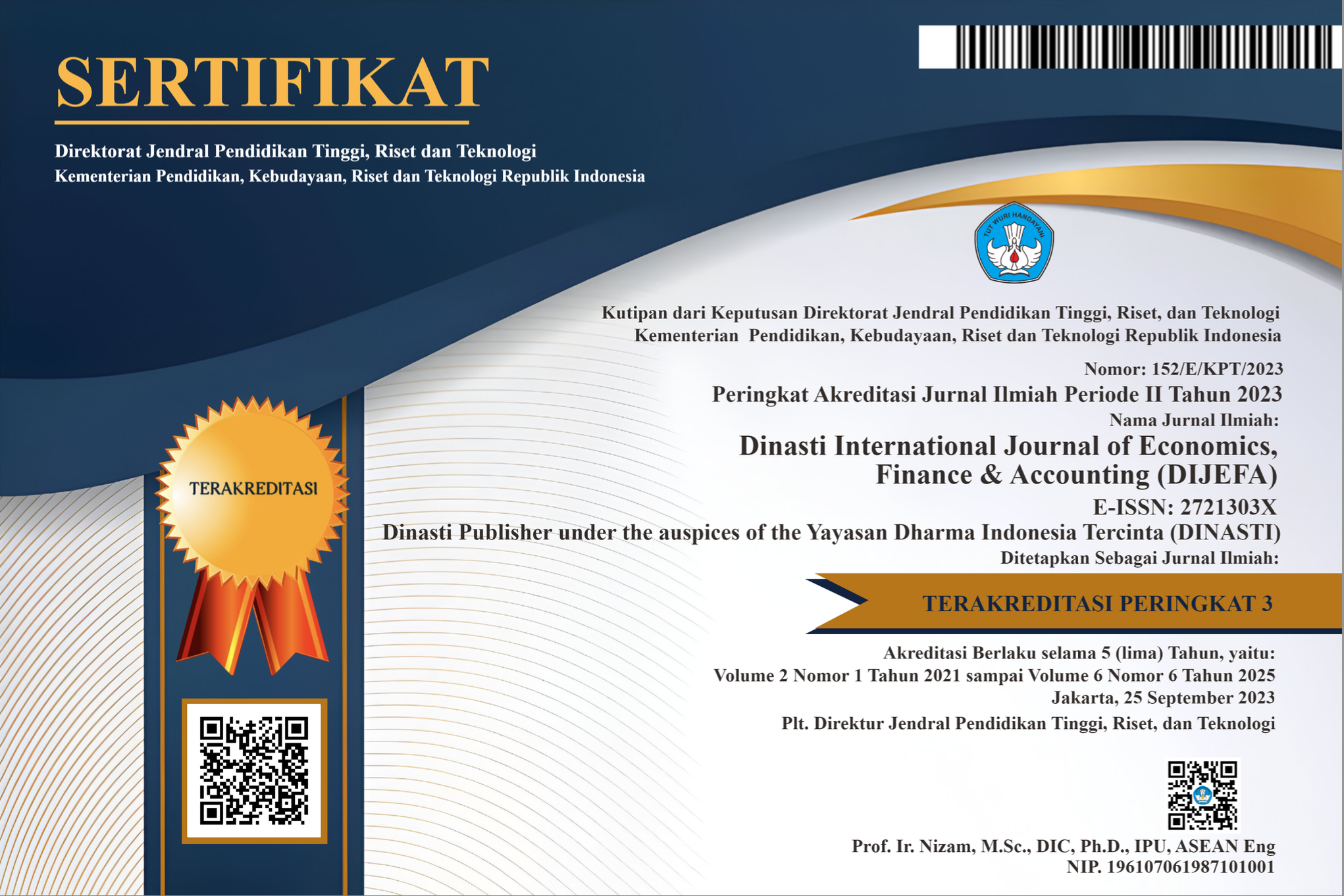The Influence of Behaviour Finance and Demographic Factors on Investment Decision Making Through Risk Tolerance as Mediation
DOI:
https://doi.org/10.38035/dijefa.v4i6.2241Keywords:
Demography Factor, Behavior Finance, Risk Tolerance, Investment DecisionAbstract
Investment decision making is something that is inevitable and a critical moment in determining the success of an investor in making their investment. This research conduct since investment decision making is very difficult to measure and seen directly. Hence, it is necessary to identify various factors that influence investment decision making including demographic factors, behavior finance, and risk tolerance. The type of research is quantitative with a population of all capital market investors who invest in shares on the Indonesia Stock Exchange (IDX), especially the LQ45 index as well as data processing uses AMOS 24. The results showed that demographic factors have an influence which causing specific behavior and tolerance thresholds related to risk, which in turn affect performance and optimization in investment decision making. Investors must also be aware of the existence of behavior finance which is found in the form of behavior or actions caused by psychological factors inherent. On the other hand, the role of risk tolerance also shapes behavior patterns and planning processes related to finance which are described in risk acceptance. Hence, the emergence of identified investor behavior will later make opportunities for momentum and investment strategies that improve the performance and success of their investments as well as the quality of excellent decision making.
References
Ahmad, M., & Shah, S. Z. A. (2022). Overconfidence Heuristic-Driven Bias in Investment Decision-Making and Performance: Mediating Effects of Risk Perception and Moderating Effects of Financial Literacy. Journal of Economic and Administrative Sciences, 38(1), 60–90. https://doi.org/10.1108/JEAS-07-2020-0116
Akhtar, F., & Das, N. (2020). Investor Personality and Investment Performance: From the Perspective of Psychological Traits. Qualitative Research in Financial Markets, 12(3), 333–352. https://doi.org/10.1108/QRFM-11-2018-0116
Aren, S., Aydemir, S. D., & ?ehito?lu, Y. (2016). Behavioral Biases on Institutional Investors: A Literature Review. Kybernetes, 45(10), 1668–1684. https://doi.org/10.1108/K-08-2015-0203
Arora, N., & Mishra, B. K. (2023). Influence of Bull and Bear Market Phase on Financial Risk Tolerance of Urban Individual Investors in an Emerging Economy. Review of Behavioral Finance, 15(4), 570–591. https://doi.org/10.1108/RBF-05-2021-0087
Asad, H., Toqeer, I., & Mahmood, K. (2022). A Qualitative Phenomenological Exploration of Social Mood and Investors’ Risk Tolerance in an Emerging Economy. Qualitative Research in Financial Markets, 14(1), 189–211. https://doi.org/10.1108/QRFM-01-2021-0006
Baker, H. K., Kumar, S., Goyal, N., & Gaur, V. (2019). How Financial literacy and Demographic Variables Relate to Behavioral Biases. Managerial Finance, 45(1), 124–146. https://doi.org/10.1108/MF-01-2018-0003
Baker, H. K., Nofsinger, J. R., & Spieler, A. C. (2020). The Savvy Investor’s Guide to Building Wealth Through Traditional Investments. Emerald Publishing Limited. https://doi.org/10.1108/9781839096082
Baker, H.K., & Puttonen, V. (2017). Investment Traps Exposed. Emerald Publishing Limited. https://doi.org/10.1108/978-1-78714-252-720171008
Bareksa Team. (2023). Kamus Investasi: LQ45. https://www.bareksa.com/kamus/l/lq-45
Beatrice, V., Murhadi, W. R., & Herlambang, A. (2021). The Effect of Demographic Factors on Behavioral Biases. Jurnal Siasat Bisnis, 25(1), 17–29. https://doi.org/10.20885/jsb.vol25.iss1.art2
Bions Team. (2022). Kenali LQ45, Indeks Saham Paling Cuan. BNI Sekuritas. https://bions.id/edukasi/saham/apa-itu-indeks-lq45
Bougie, R., & Sekaran, U. (2020). Research Method for Business a Skill Building Approach Eight Edition. Wiley, Asian Edition.
Butler, C. (2022). Understanding Risk Tolerance. https://www.investopedia.com/articles/pf/07/risk_tolerance.asp
Chaffin, C. R. (2018). Client Psychology First Edition. Wiley, New jersey.
Cupák, A., Fessler, P., & Schneebaum, A. (2021). Gender Differences in Risky Asset Behavior: The Importance of Self-Confidence and Financial Literacy. Finance Research Letters, 42, 101880. https://doi.org/10.1016/j.frl.2020.101880
Feldman, T., & Liu, S. (2023). A New Behavioral Finance Mean Variance Framework. Review of Behavioral Finance, 15(3), 355–370. https://doi.org/10.1108/RBF-05-2021-0088
Grable, J. E., Joo, S.-H., & Kruger, M. (2020). Risk Tolerance and Household Financial Behaviour: A Test of The Reflection Effect. IIMB Management Review, 32(4), 402–412. https://doi.org/10.1016/j.iimb.2021.02.001
Hsu, Y.-L., Chen, H.-L., Huang, P.-K., & Lin, W.-Y. (2021). Does Financial Literacy Mitigate Gender Differences In Investment Behavioral Bias? Finance Research Letters, 41, 101789. https://doi.org/10.1016/j.frl.2020.101789
Isidore, R., & Christie, P. (2019). The Relationship Between the Income and Behavioural Biases. Journal of Economics, Finance and Administrative Science, 24(47), 127–144. https://doi.org/10.1108/JEFAS-10-2018-0111
Jensen, G. R., & Jones, C. P. (2020). Investment Analysis and Management Fourteenth Edition. Wiley, Asian Edition.
Metawa, N., Hassan, M. K., Metawa, S., & Safa, M. F. (2019). Impact of Behavioral Factors on Investors’ Financial Decisions: Case of The Egyptian Stock Market. International Journal of Islamic and Middle Eastern Finance and Management, 12(1), 30–55. https://doi.org/10.1108/IMEFM-12-2017-0333
Mittal, S. K. (2022). Behavior Biases and Investment Decision: Theoretical and Research Framework. Qualitative Research in Financial Markets, 14(2), 213–228. https://doi.org/10.1108/QRFM-09-2017-0085
Nigam, R. M., Srivastava, S., & Banwet, D. K. (2018). Behavioral Mediators of Financial Decision Making – a State-of-Art Literature Review. Review of Behavioral Finance, 10(1), 2–41. https://doi.org/10.1108/RBF-07-2016-0047
Özen, E., & Ersoy, G. (2019). The Impact of Financial Literacy on Cognitive Biases of Individual Investors (pp. 77–95). https://doi.org/10.1108/S1569-375920190000101007
Raheja, S., & Dhiman, B. (2020). How do Emotional Intelligence and Behavioral Biases of Investors Determine Their Investment Decisions? Rajagiri Management Journal, 14(1), 35–47. https://doi.org/10.1108/RAMJ-12-2019-0027
Rahman, M. (2019). Propensity Toward Financial Risk Tolerance: An Analysis Using Behavioural Factors. Review of Behavioral Finance, 12(3), 259–281. https://doi.org/10.1108/RBF-01-2019-0002
Rasool, N., & Ullah, S. (2020). Financial Literacy and Behavioural Biases of Individual Investors: Empirical Evidence of Pakistan Stock Exchange. Journal of Economics, Finance and Administrative Science, 25(50), 261–278. https://doi.org/10.1108/JEFAS-03-2019-0031
Ritika, & Kishor, N. (2022). Development and Validation of Behavioral Biases Scale: a SEM Approach. Review of Behavioral Finance, 14(2), 237–259. https://doi.org/10.1108/RBF-05-2020-0087
Rutten, M. E. J., Dorée, A. G., & Halman, J. I. M. (2013). Exploring the Value of a Novel Decision?Making Theory in Understanding R&D Progress Decisions. Management Decision, 51(1), 184–199. https://doi.org/10.1108/00251741311291382
Sarkar, A. K., & Sahu, T. N. (2018). Investment Behaviour Towards an Individual-Centred Financial Policy in Developing Economies. Emerald Publishing Limited. https://doi.org/10.1108/9781787562790
Sharma, A., & Kumar, A. (2019). A Review Paper on Behavioral Finance: Study of Emerging Trends. Qualitative Research in Financial Markets, 12(2), 137–157. https://doi.org/10.1108/QRFM-06-2017-0050
Smart, S. B., Gitman, L. J., & Joehnk, M. D. (2017). Fundamental of Investing 13th Edition. Pearson Education Limited, England.
Sugiyono. (2022). Metode Penelitian Kuantitatif Kualitatif dan R&D. ALFABETA, Bandung.
Twin, A. (2022). What is Risk Tolerance and Why Does it Matter? https://www.investopedia.com/terms/r/risktolerance.asp#:~:text=Risk tolerance is a measure,an investor’s tolerance for risk.
Wong, A., & Carducci, B. (2016). Do Sensation Seeking, Control Orientation, Ambiguity, and Dishonesty Traits Affect Financial Risk Tolerance? Managerial Finance, 42(1), 34–41. https://doi.org/10.1108/MF-09-2015-0256
Yao, Z., & Rabbani, A. G. (2021). Association Between Investment Risk Tolerance and Portfolio Risk: The Role of Confidence Level. Journal of Behavioral and Experimental Finance, 30, 100482. https://doi.org/10.1016/j.jbef.2021.100482
Zahera, S. A., & Bansal, R. (2018). Do Investors Exhibit Behavioral Biases in Investment Decision Making? A Systematic Review. Qualitative Research in Financial Markets, 10(2), 210–251. https://doi.org/10.1108/QRFM-04-2017-0028
Downloads
Published
How to Cite
Issue
Section
License
Copyright (c) 2024 Elkunny Dovir Siratan, Tannia Tannia, Sophia Reni Susilo, Angelia Cristia Dewi, Wily Dozen

This work is licensed under a Creative Commons Attribution 4.0 International License.
Authors who publish their manuscripts in this journal agree to the following conditions:
- The copyright on each article belongs to the author(s).
- The author acknowledges that the Dinasti International Journal of Economics, Finance & Accounting (DIJEFA) has the right to be the first to publish with a Creative Commons Attribution 4.0 International license (Attribution 4.0 International (CC BY 4.0).
- Authors can submit articles separately, arrange for the non-exclusive distribution of manuscripts that have been published in this journal into other versions (e.g., sent to the author's institutional repository, publication into books, etc.), by acknowledging that the manuscript has been published for the first time in the Dinasti International Journal of Economics, Finance & Accounting (DIJEFA).


























































